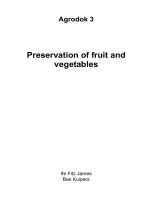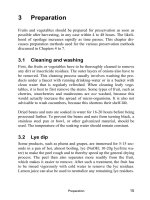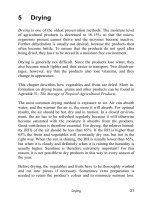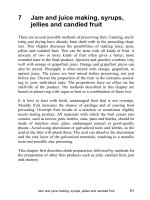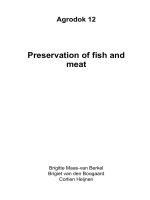Preservation of fish and meat - Part 8 potx
Bạn đang xem bản rút gọn của tài liệu. Xem và tải ngay bản đầy đủ của tài liệu tại đây (232.54 KB, 14 trang )
Preservation of fish and meat
64
8 Canning
8.1 General information
First, some general information about canning of fish and meat will be
given. This covers the advantages and disadvantages of the process,
packaging materials and materials needed. After this general introduc-
tion, the following will be described: preparation of fish and meat,
processing techniques and storage of the product.
A lot of canning equipment is manufactured in the U.S. Therefore
pressures and temperatures will be given both in metric and American
measuring units (e.g. pounds/inch
2
and degrees Fahrenheit).
Principle and limitations
The canning process involves placing foods in cans or jars and heating
them to a temperature that destroys micro-organisms that could be a
health hazard or cause the food to spoil. Canning also inactivates en-
zymes that could cause the food to spoil. As the cans or jars are sealed
hermetically, re-contamination from outside is prevented. In general,
canned products can be stored for a long time without refrigeration.
Chemical quality loss (in taste, colour and amount of certain essential
nutrients) will slowly continue though.
Not all products can be heated in the same way. The amount of time
and the temperature needed depends on:
? the number and kinds of micro-organisms and the form (active cells
or spores) in which they are present
? water content of the product
? acidity of the product
? presence of salt and/or other inhibitors of bacterial growth
? fat content of the product
? shape and size of the tin can or glass jar
? storage temperature
Canning
65
In fish and meat the number of micro-organisms initially present may
be large, the internal water content is high and the pH is close to neu-
tral. It is therefore difficult to kill all micro-organisms present and to
get a safe product. The only safe way to sterilize low acid products
such as fish and meat is by prolonged heating in a pressure canner or
sterilizer in which temperatures higher than 100 °C (212
0
F) can be
reached.
The main reason pressure canning is necessary is the hazard of the
Clostridium botulinum bacterium. Though the bacterial cells are killed
at boiling temperatures, they can form spores that can withstand these
temperatures. The spores grow well in low acid foods, in the absence
of air, such as in canned low acid foods (vegetables and meats). When
the spores germinate and grow to high numbers, they produce the
deadly botulinum toxins (poisons). The spores can be destroyed by
canning the food at a temperature of 115-121
0
C (240-250 °F) for the
correct length of time. This temperature can only be reached in a pres-
sure canner.
As the canning of fish and meat requires a lot of energy, clean
water and a large investment in equipment, usually it can only be
done at a small-scale industrial level. It is less suited for
household-level preservation.
8.2 Advantages and disadvantages of the
canning process
Advantages of canning:
? The product can be stored longer and more safely.
? A good-quality product is ensured with fish and meat; it is better
than that of foods preserved by other methods like drying in the sun.
The best quality is achieved by using fresh, healthy products and by
exactly following the heating specifications for that product.
Preservation of fish and meat
66
Disadvantages of canning:
? The high price of the preserved foods due to the following:
-Glass or tinned steel packaging materials must be used, and may be
expensive and difficult to obtain. Glass can be reused.
-The processing equipment is, when compared with sun drying or
smoking, very expensive. The costs for canning in glass jars are
less.
-The process requires a lot of fuel.
? The process requires more clean water than other methods do.
? The extended heating at high temperatures causes both a decrease in
taste and vitamin losses. The nutritional value of the food, com-
pared to the fresh product, is therefore somewhat lower. Nutrients
dissolving in the brine are lost if these juices are not consumed.
In this chapter, the methods for canning and sterilizing a variety of
fish and meats are given. Because the packaging materials are very
important in the procedures, these will be discussed first.
8.3 Packaging materials
General
Cans made of tinned steel plate are especially used to store fish and
meat products. Sometimes it is better to use glass; acid products, for
example, corrode cans and are therefore better packed in glass. The
shape and volume of the vessels must be chosen according to the
quantity to be processed. Big bulky products such as pieces of meat
must be sterilized in small or flat tin cans or jars which allow the heat
to penetrate quickly to the centre of the product. Small products and
products in brine, etc., can be packed in all shapes and types of tin
cans or jars.
The contents of an opened tin can or jar must be consumed as quickly
as possible (in any case within 24 hours), which implies that the
amount of food put in one can or jar should be adjusted to the amount
of food consumed during one meal or in one day. Of course, it is true
that the larger the tin cans or jars, the cheaper the packaging material
Canning
67
will be per kilo of processed product. But in general, larger tin cans or
jars with meat must be heated longer (see Table 2 in Chapter 8.6),
which means that the quality is usually somewhat lower than that of
meat in smaller tin cans or jars.
Tin cans
Tin cans are steel cans which are covered with a thin layer of tin. They
are used especially for sterilizing and are very suitable for sterilizing
larger amounts. Unfortunately they can only be used once. There are
many different types of tin cans available with varying capacities and
shapes (cylindrical = long and thin, flat = wide and shallow). Tin cans
can also vary according to the presence or absence of a layer of var-
nish on the inside. For fish and meat unvarnished tin cans are often
suitable.
Every tin can has a lid which can be
hermetically sealed with a tin can
seamer. Various types of seamers are
available, ranging from simple hand-
operated tools to new, automatic ma-
chines. The seam must be made cor-
rectly so as to prevent leakage. This can
be checked by closing the tin can with a
little amount of water and immersing it
in boiling water. If, after a few minutes,
steam escapes, the seaming machine
must be readjusted and a newly seamed
can must be checked again, as described
before.
New tin cans delivered from the factory are fairly clean and do not
require extra washing. However, do check that they were not contami-
nated during storage. Do not use damaged or corroded cans. Store
them upside down to keep dirt out. If they are not clean, wash them in
hot soda water (1.5 wt% sodium carbonate), rinse with hot water and
let them drip dry on a clean cloth. The lids must also be clean.
Figure 19: Can seam
Preservation of fish and meat
68
Glass jars
Glass jars can be used for sterilizing under pressure and for bottling.
Glass is used less frequently for fish and meat as large pieces of fish
or meat are difficult to get out and the product does not look as nice.
However, glass is a good option for small and acidic products. Fur-
thermore, at the (large) household level sterilizing products in glass
jars in a pressure canner may be an economically feasible option.
Glass has the advantages that it can be reused after the product has
been consumed and it does not affect the product. The fragility of
glass, its weight, poor heat conduction and the fact that light can get to
the product are some disadvantages.
Jars and lids must be cleaned before use with soap (soda) and hot wa-
ter. Keep clean jars in hot water until they are needed. Jars come in
different sizes. Manufacturers have their own rings, lids and some-
times clamps which fit on jars. The best results are achieved when all
parts are obtained from the same manufacturer.
8.4 Processing equipment
The items needed for the whole process are:
? tubs for washing and rinsing fish, meat, tin cans, jars, etc.
? cutting equipment: tables, knives
? kettles for heating, boiling, pre-boiling, processing
? shallow open pans for sterilizing at 100 °C (212
0
F) for acid prod-
ucts like fish in tomato sauce
? a sterilizer (autoclave, Figure 21) or pressure canner (Figure 20) for
sterilizing at temperatures higher than 100 °C (212
0
F) for ‘low
acid’ products. These include almost all meat and fish products.
Note: There are various types of pressure canners (Figure 20). Not
all pressure cookers are suitable as canners. In a good canner a pres-
sure of at least 1 atmosphere (101.3 kPa or 14.7 pounds per square
inch) above atmospheric level should be attainable.
? a thermometer to check the temperature
? cans or glass jars with lids
? (hand-operated) seaming machine for seaming tin cans
Canning
69
Figure 20: Pressure canners
8.5 Preparation
Clean and tidy work pays off in lower levels of micro-organisms and a
greater chance the process will be successful. Chapter 3 describes how
to clean fish and cut meat into strips. A few remarks are made below
about preparations specific to the canning of fish and meat.
Fish
For the canning of fish, it is also important that the fish to be canned is
brought ashore as quickly as possible. The mechanization of fishing
boats, transporting on ice and cooling facilities are useful for that. Es-
pecially fatty kinds of fish spoil quickly, due to oxidative rancidity.
Good personal hygiene among fishermen and processors and hygienic
conditions in harbours and factories are also necessary for the proper
processing of the fish.
Not all kinds of fish are suitable for canning. When boiling fish with
white flesh, the flesh will rapidly fall apart leaving hard bones. Thus
these kinds of fish are unsuitable for canning. Fish with a high fat con-
tent (usually fish which swim in schools such as herring, mackerel,
Preservation of fish and meat
70
tuna and sardines) have much firmer flesh and softer bones. When
cooking such fish, the bones get soft before the flesh starts to fall
apart. The fish thus retain their original shape and are very suitable for
canning. Another advantage of canning fatty kinds of fish is that the
oxygen entrapped in the can will be consumed during sterilization and
this will prevent fat oxidation and rancidness, which is not achieved
with simpler preservation methods such as drying, etc.
Start with fresh, healthy fish. Wash them and gut them in such a way
that the intestines do not touch the flesh while being removed. Re-
move the head and tail, and the bones of large fish, then wash the fish
thoroughly in cold water. The fish can be tinned raw, but preferably
fried or cooked. Fish is often also salted, pickled, smoked, etc. after
being cleaned and before canning. The protein thus denatures which
makes the flesh stay firm and not shrink after canning.
Use as little herbs and spices as possible. These are often a source of
contamination with bacterial spores. Put small fish straight up in flat
oval cans (herring). Big fish have to be cut into smaller pieces to get
them into small tin cans.
Meat
Bottling meat at 100 °C (212
0
F) is not advisable but sterilizing it at
115-121
0
C (240-250
0
F) is possible. Use only clean, fresh pieces of
meat. Remove the bones, cut the meat into smaller pieces (a few cm
thick) and season as desired. Brown the meat by roasting or frying;
big pieces should be partially cooked before frying. For small pieces
in sauce, stock or brine, various sizes of tins and jars can be used. For
bigger pieces, use flat tin cans.
In general, almost all meat products are suitable for canning. Only
products which are eaten raw such as raw dry-cured ham or dry sau-
sage are not suitable.
Canning
71
8.6 Processing techniques
A simple description of the process of canning fish or meat is given
below:
? Prepare fish or meat (Chapter 3)
? Precook (or roast/smoke) meat and fish; this reduces volume and
makes the flesh firmer.
? Fill tin can with fish or meat and filling liquid.
? Remove excess air from can, but keep the required headspace.
? Seal can shut with seamer
? Apply heat treatment (115-121
0
C/240-250
0
F for most fish and
meat products or 100 °C / 212
0
F for sour products)
? Cool can, wash it and affix label.
Filling and closing containers
After initial preparation, the products, which are still warm or heated
to the filling temperature, are put into tin cans or glass jars as quickly
as possible. These are then filled with hot water, hot broth, hot salt
solution or hot oil to about half a centimetre under the rim. This is
called the headspace; it is needed to give the food inside the jar room
to expand during heating and to create a vacuum in the jar after cool-
ing. Take care that no air pockets are sealed in with the product.
Glass jars can be closed at this point. The lid should fit well, but (for
example in the case of a screw cap) it should not be twisted tightly
closed, because some air should be allowed to escape while the jar is
being heated. Immediately after the heating process the lid should be
closed tightly. This way a vacuum will develop in the jar as the prod-
uct cools and the food inside has no more chance of coming in contact
with outside air and becoming contaminated.
Tin cans can be sealed after adding the liquid, as long as the middle of
the product has reached the sealing temperature. Always measure the
temperature in the middle of the tin can. The sealing temperature must
not be lower than 60-80 °C (140-176 °F), depending on the product
and the size of the can. If it is lower, the cans must be quickly reheated
in a shallow water bath until the temperature in the middle of the tin
Preservation of fish and meat
72
can is equal to or higher than the indicated temperature. This proce-
dure ensures that the can will not deform at the sterilizing temperature
and that a proper vacuum is created after cooling.
The time between filling, sealing and sterilizing must be as short as
possible. Never use damaged cans or jars.
Sterilizing using an autoclave or pressure canner
In low acid products spores of pathogenic (disease causing) micro-
organisms, which are not killed at 100 °C/212 °F can grow and multi-
ply. To kill those spores sterilization for 60 minutes or longer at 121
°C (250 °F) may be necessary. At 115 °C (240 °F) spores will be
killed too, but it takes longer (Table 3). Sterilizing below 115
0
C (240
0
F) is generally not safe.
To sterilize at temperatures higher than 100 °C (212 °F), a pressure
canner or autoclave is needed. These high temperatures can be reached
only through increased pressure. At sea level water boils at 121 °C
(250 °F) when the pressure inside an autoclave is one atmosphere
(equivalent to 101.3 kilopascal) above atmospheric pressure. At 0.7
atmospheres above atmospheric pressure, water boils at 115 °C (239
°
F). In higher areas, greater pressure is needed to attain the required
temperature. As a rule of thumb, 0.1 atmospheres (1.5 pound/square
inch) of extra pressure is needed per 1000 metres above sea level. See
Table 2.
Table 2: Pressure required to reach canning temperature
Altitude Required Canning Pressure
for 115
0
C/240
0
F for 121
0
C/250
0
F
pounds/inch
2
kilo-pascal pounds/inch
2
kilo-pascal
Sea level
2000 ft (609 m)
4000 ft (1219 m)
6000 ft (1829 m)
10 68.9 15 103.4
11 75.8 16 110.3
12 82.7 17 117.2
13 89.6 18 124.1
Canning
73
Many household canners are fitted with counterweights of 5, 10 and
15 pounds as pressure regulators (Figure 20). Above 300m (1000 ft)
the 15-pound weight should be used.
The general method of working is as follows:
? Cover the bottom of the pressure canner with water.
? Place the basket with the jars in the pressure canner. The holes in
the basket must not all be blocked, as steam must be able to pass
through. Remember to unscrew the jar lids a little bit.
? Seal the pressure canner and open the ventilation system. Apply
heat. The autoclave may be heated by gas or by electricity and in an
industrial setting frequently saturated steam is directly injected in
the retort.
? After steam has escaped for 10 minutes, close the ventilation system
(the air has by then been evacuated) and let the pressure build up.
? When the required temperature is reached, the cooking time starts.
Cooking times depend on the product, can shape and size, tempera-
ture and pressure. For any specific situation consult experts like re-
search institutes, can manufacturers or manufacturers of sterilizing
equipment. In Table 3 some indicative values are given for safe
processing at household level. Keep the temperature and pressure as
constant as possible during cooking by regulating the heat source.
? Tin cans
: After the process, let the steam escape slowly. This can be
done faster with small tin cans than with bigger ones, but nonethe-
less should be done slowly and carefully as the cans can deform or
even burst. When the pressure is again normal, the lid of the canner
can be opened. Remove the tin cans and immerse them in cold wa-
ter, replacing the water now and then to keep it cold. When the tin
cans have cooled down enough (i.e. when they feel hand-warm),
they still contain sufficient heat to dry by themselves if stored in the
open air.
? Glass jars
: Wait until the pressure canner cools down and the pres-
sure inside has gone down before opening the lid. Remove the jars
and tighten the lids immediately. A disadvantage of glass jars is that
they cannot be cooled quickly. The safest way to cool them is to
Preservation of fish and meat
74
leave them in open air until they are hand-warm and then to put
them in cold water.
Table 3: Indicative cooking times
Product Can size
(litre)
Processing time (minutes)
115
0
C (240
0
F) 121
0
C (250
0
F)
Chicken
Beef, pork
Fish
Meat stock
0.5
1.5
0.5
1
0.25
0.5
1.5
0.5
1
95 75
155 125
90 75
120 90
75 60
105 85
220 180
30 20
40 25
A second technique for sterilization with an autoclave uses more en-
ergy and water but gives a slightly better product. The autoclave is
completely filled with water and the tin cans and jars are put in it. The
process proceeds as above. The cooling can be quickened by slowly
removing the hot water and adding cold water to the autoclave after
sterilization. During cooling, the pressure in the autoclave must be
reduced gradually.
Sterilizing sour products in a boiling water bath
Sour fish products, such as fish in tomato sauce, are barely heated
(e.g. 5 minutes at 100 °C / 212
0
F) as most micro-organisms will not
survive in an acidic environment anyway. A boiling water bath is used
to preserve sour products.
To prevent glass jars from breaking, start with hot but not yet boiling
water. Tin cans can go straight into boiling water. Cans or jars should
be completely under water. Start timing the process from the moment
the water boils again, making sure that the water remains at a rolling
boil during the entire sterilization period. An open water bath boils at
100 °C (212 °F) at altitudes of up to 300 metres above sea level. At
Canning
75
greater altitudes, water boils at a lower temperature and the products
must be sterilized longer to achieve the same effect, as shown in Table
4.
Figure 21: A steam-heated autoclave
Table 4: Time needed for sterilization at different altitudes
Altitude (metres) Sterilization time (minutes) (for example when a = 20 min.)
0-300
300-600
600-900
900-1200
a
a + 1/5*a
a + 2/5*a
a + 3/5*a
20 min
24 min
28 min
32 min
After heating, the cans can be cooled in cold water, which should be
changed occasionally to speed up the cooling. Glass jars should be put
into cold water only when they are lukewarm. The cooling can be
speeded up by gradually adding cold water to the hot water in the
sterilizer. When doing so, one should use chlorinated water (water
Preservation of fish and meat
76
containing 0.01 wt% chloride of lime = bleaching powder, available
worldwide) so that the cans with possible micro leaks are not con-
taminated.
8.7 Storage
Store the canned foods in a cool place. Label them so that you know
the contents. The storage temperature should preferably stay below
20 °C (68 °F); the cooler the better, as chemical quality degradation
still continues after canning. With conventional canning techniques as
described in this chapter not all bacterial spores may be killed. Fortu-
nately, these heat resistant survivors do not grow at temperatures be-
low 35 °C. If you want to store the product for a long time (up to 2
years) in tropical conditions with higher temperatures (of 35 °C or
more), than a much more intensive heat treatment at 121 °C (250 °F)
is necessary so that all micro-organism spores are inactivated. This is
expensive in terms of fuel and will lower the quality of the canned
product. Do not pile the preserved foods too close to each other; air
should be able to circulate. The storeroom should also be dry and kept
at a constant temperature. Only ventilate with dry air; avoid ventila-
tion in warm, humid weather, as condensation could rust the tin cans.
Always consume the oldest preserved foods first. Check each product
for spoilage.
Pasteurized meat products (heat treatment at 80 °C / 176 °F) can be
kept in cooling cells (2-4 °C / 35.5-39 °F) for up to 6 months.
8.8 Setting up a small-scale canning factory:
prerequisites
Apart from the materials that are needed, there are also a number of
other prerequisites to be met to ensure the success of a small-scale fish
or meat canning factory.
Canning
77
Some important prerequisites are:
? sufficient clean water and energy
? good infrastructure (roads, cooling facilities, harbours, slaughter-
houses, etc.)
? financial feasibility: Is there a sound business plan?
? sufficient trained personnel to operate machines and the right level
of skills for bookkeeping and management
? technical support: machine maintenance and supply of spare parts
? regular supply of fish or meat at a reasonable price (Certain kinds of
fish are not available at certain times of the year.)
? good temperature control during the process
? testing of chemical and micro-biological quality after the process
(Laboratory facilities are needed for this.)
? a good market for canned fish or meat. If export is also possible,
apart from local trading, the cost of a can of fish or meat can be
lowered.
Some publications in this Agrodok series provide valuable information
related to some of the above issues: marketing for small-scale produc-
ers is discussed in No. 26 and includes chapters on product selection,
management, finance, cooperation and organization and cost price
calculation; storage techniques for tropical agricultural products are
explained in No. 31; preservation and processing techniques are dis-
cussed in No. 3 (fruit and vegetables), No. 12 (fish and meat), Nro 36
(dairy products) and No. 22 (weaning foods). Strongly recommended
is the CTA Publication ‘Setting up and running a small food business’
(see page 84).
Unless all of the above prerequisites for canning are satisfied, it is bet-
ter not to set up a fish or meat canning factory. Canning of meat under
primitive conditions is not to be recommended. However, if one can
meet all the necessary requirements and canning fish or meat proves
to be economically feasible, then the local canning of fish or meat will
certainly make a positive contribution to the diet of the local popula-
tion.





